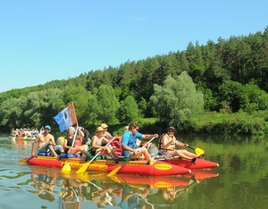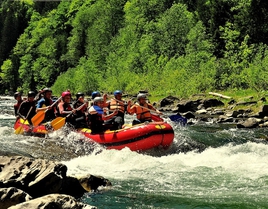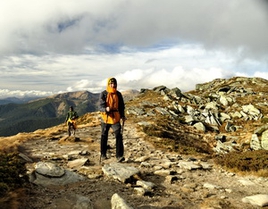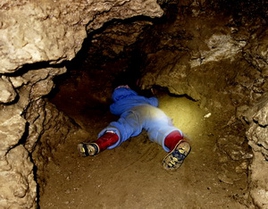Wild waters of the Cheremosh
Cheremosh begins from the merger of White Cheremosh and Black Cheremosh, not far from Usteriky village, and falls into Prut not far from Nepolkivtsi village. It is the biggest tributary of Prut. The border between Chernivtsi and Ivano-Frankivsk regions laid along the river.
Higher part of river during 33 km lies in the narrow mountain valley with a very steep slopes covered by forest, and higher on it – there are «polonyny». This area is very good for rafting on the Cheremosh.
The riverbed is sinuous, stream speed is high. During mean-water period the width of riverbed varies from 5-15 m to 25-50 m, depth changes between 0,2-0,4 m in higher part of river and 0,7-1,0 m in lower part. The speed of stream is over 1,5 m/s, and in the some areas it is 3-3,5 m/s. During flooding a depth increases to 3-4 m, speed of stream to 4-5 m. There are two rapids here – Ketlyshche and Sokilsky.
In the foothill-flat part (47 km length), which begins after river exits from the mountains behind Vyzhnytsya, Cheremosh flows in the wide valley (3-5 km and more), the slopes are pretty low, flat, terraced. The floodplain is very advanced, overgrown by willow, other shrubs, alder and others. The speed of stream decreases, river puts aside a thick layer of everything what it brought from the mountains. Through these gravel fields the river washed many distributaries, which after every flooding, change their location. The area is good for rafting, but it is not the typical rafting on the mountain river.
The river width together with islands and channels is from 70 to 500 m. The average depth during mean water period is 0,6-1,0 m, and average speed of stream is 0,7-1,2 m/s. When the flooding begins, its depth increases to 2-3 m, and speed – to 3,5-4,5 m/s. Rafting in this location of Cheremosh requires maximal attention and concentration.
There are many small tributaries. Table gives name of rivers with length over 10 km. There are not technical information about tributaries of Black and White Cheremosh. Some tributaries in some areas have different names. The basic is a name of its mouth.
Rafting direction
- The merger of Black and White Cheremoshes and the beginning of Cheremosh, 488 meters above sea level. 1,3 km. Usteriky village (church), 485 m.
- 4 km. Mouth of the Putyla river, 475 m.
- 4,9 km. Barvinkovo village, left bank.
- 5,3 km, Marenuchi village (church), right bank, 460 m. 9,8 km.
- 9,8 km. Biloberizka village, 426 m, righ bank.
- 12,3 km. Mouth of Tovarnutsia river, right bank.
- 17 km. Rostoky village, 372 m.
- 26 km. Rapid Ketlyshche. A highway bridge is built over the rapid, there is a canal under it with a pretty high water falling. After it – a path with the standing waves.
- 28 km. Rapid Sokilsky, it is little bit lower than left-bank village Big Rozhen. The reference point is very steep turn of riverbed, and left bank rises as vertical rock wall, and there is a roadway under it. At the rapid there is a high wave, not strong casting on the left bank, and big underwater stones in the riverbed. After rapid the right bank in some places touches to water too.
- 35 km. Vyzhnytsia, 330 m.
- 60 km. Banyliv village, right bank.
- 64 km. Vashkivtsi, 214 m.
- 800 km. Mouth of Cheremosh, 200,8 meters above sea level.
After merger of Black and White Cheremoshes the river becomes a high-water, because of that rafting on the kayaks may occur here during all summer. There are high waves on the big number of «shyvery». There are many villages on the coast.
On the Chremosh’s banks

In 4 km lower than Usteriku, in the mouth of the right tributary of Putyla, on its both banks the Ust-Putyla village is situated. Almost in the centre of the village, little bit lower than mouth of Putyla’s right tributary – Biskiv, there is a high 30-meters rock near the road, seemed as figure of person.
There is an interesting legend about this nature creation. Long time ago a greedy and evil landowner controlled all woods, «polonyny» and everything around. Once she met a poor widow, which begged her. The rich woman became angry and threw stone at the beggar instead of alms. And widow said: «I wish you to turn into the stone!». And the miracle happened: people watched that landowner turn into the stone rock and remained to stay near the road forever. Since this time that rock is called by people the Stone Rich Woman. L. Novytsky wrote a play «The Stone Rich Woman» based on national legends, which was played with a success in a lot of theatres of Ukraine.
Near the mouth of Putyla there are channels on Cheremosh between low gravel islands, rifts become deep, and «shyvery» more rarely block the riverbed. Some islands are overgrown by rare bushes.
Behind Marenychi near the bank there is a geologic monument – the Frog stone. It is a big sandstone boulder with a size 3x5 m, which looks like a frog.
According the old legend this boulder fell from the mountain, when pan’s army chased the national avengers – opryshky. The Cheremosh’s water rose and blocked the road for chasers.
Biloberezka village. Here in May 1967 the first republic competitions in technique of water tourism started for the prize of the newspaper «Youth of Ukraine», and then there was a match in water tourism among 10 cities of USSR. These competitions were an impetus for the development of water tourism on Cheremosh. Nowadays in spring and in winter the hundreds of teams on different types of boat challenge the wild waters of this picturesque river. The competitions for «Cheremosh Cup» are arranged every year. The popularity crossed the border of Ukraine. Now on the river we can see the tourists not only from CIS (Commonwealth of Independent States) countries, but even from Europe.
Next village, which lies along the banks of Cheremosh almost in 10 km, is Rostoky. On the left bank there is Rostoky of Ivano-Frankivsk region, on the right bank – Rostoky of Chernivtsi region. The village was named such because of river’s name. In this place Cheremosh spreads into distributaries in the wide riverbank. The village is very picturesque. Lesya Ukrainka, which admired Rostoky from the neighboring peaks, called this village «beautiful and silver as a dream». It is a homeland for the chieftain of Bukovyna opryshky Muron Shtolyuk and the place of educational activity for Yuri Fedkovuch. Here he wrote the poem «To my brother Oleksa Chernyavsky, who built the bridge over Cheremosh in Rostoky», in which he expressed his old dream about reunion of all Ukrainian lands.
| Мости ти, мій друже, Єднай нашу Батьківщину З Червоною Русев. Най Черемош запінений І Чорний, і Білий Із братією руською Нас більше не ділить. |
In several kilometers lower than roadway, which lies along right bank of Cheremosh, there is a branch of road, which wriggles on the slope of Bereza spine, stretches to the Nimchyn pass and then into Vyzhenka village, which is situated in the valley of river with the same name as village.
The beautiful views of Carpathians and Cheremosh valley open from the pass. The pass is a starting point for excursions to the Dovbush Cavern on the slopes of Zaharych mountain (832 m), and if to go south, to amazing nature memorial of Bukovyna Carpathians – the natural boundary Impaled Stones. These are real complexes of the giant stone rocks, which are scattered by groups in the forest on spine slope. There are a lot of them not only under ridge, but even on the slopes below, in the valley of channel Smugar. In this exotic place many episodes for the movies «The white bird with black sign» and «Zakhar Berkut» were shot.
On the cliffs of this nature boundary the rock-climbers, alpinists pass their training, the competition of different ranks and types of mountain sport hold here.
After Pidzakharychi the roadway proceeds on the left bank of Cheremosh. Here, under bridge, there is a rapid Ketlyshche, interesting for rafting on the catamarans. And lower – the rapid Sokilsky.
After rapid the spurs on the left bank approach to the river and end up in the water as vertical walls.
In last kilometers before Vyzhnytsya the river escapes from mountains and divides into several channels, creating the picturesque islands. On the left bank the Kuty village of Ivano-Frankivsk region begins, and on the right bank – tourist base «Cheremosh» in the outskirts of Vyzhnytsya.
At first Kuty was mentioned in the chronicles of 1448. But this territory was settled earlier, the found residues of fortifications and Old Russian burial ground evidence about it. The village name is connected with its location in the corner («Kut» - Ukrainian) between Carpathians and Cheremosh. Since XVIII century Kuty, after it got the town right, became a considerable trade center, thanks to colony of Armenians, which escaped here from Persian and Turkish conquerors.
Armenians history in Ukraine counts many centuries. Even in second half of XI century the Armenians, who left their country after the fall of Shirak Bahratidske kingdom under Turkish-Seljucks attacks, found a refuge in Kyiv. And then 800 long years Ukrainian lands received unfortunate Transcaucasians. Armenian colonies appeared in Lutsk, Lviv, Volodymyr, Kamyanets-Podilsky and other cities.
During Persian-Turkish wars a new wave of refugees arose, and part of it moved through Moldova to Galicia. The old colonies renewed and new colonies arose: in Stanislav, Tysmenytsya, Yazlovets, Snyatyn, Berezhany, Pidgaytsi, Buchach, Gorodenka, Brody, Zamostia, Zolochiv.
Kuty colony was the youngest and the biggest one in Pokuttia. In the beginning of XVIII century the first group of settlers appeared near Cheremosh. They liked town. The nearby ever green mountains, noisy river, stone roads, fields, warm summer – everything looked like motherland for refugees. Besides, Kuty was situated on the old trade way, which ran to the west through Kolomya, Stanislas, Lviv, Brody, to the south – in Hungary, to the east – in Voloshchyna, Transylvania, and then in Constantinople (the old name of Armenians Ottoman empire).
In Kuty Armenians built a church and huch (a public meeting house). On the big number of yards they equipped the tabakharni – the skinner’y shops, where they created known for all Europe Armenian morocco, made from the goat skin. The blacksmith shops, carpet-making workshops, tailor workshops, shoe shops opened here. They were willing to trading, so they ousted Jews, and opened their trading shops and tents.
During ten years Armenian settlement grew, extended and counted about 200 yards. Closed economically and administratively, separated by religion Armenian colony were the only colony in Galicia, which still didn’t felt the pressure of Uniates and saved its integrity.
In different times Ivan Franko, Lesya Ukrainka, Vasyl Stefanyk, Les Martovych and other writers and artists were and lived in Kuty.
On the right bank, behind the tourist base Cheremosh, the tributary Vyzhenka flows in. In several kilometers upstream there is a village with the same name, it’s a main balneal centre of Bukovyna.

After the tributary Vyzhenka there is a Vyzhnytsia – a regional center of Bukovyna. At first it mentioned by Moldavian chronicler N.Nekulche in 1501 as a lord’s Stephan III gift to one of his boyar. In 1767 Vyzhnytsia got a right of trading town, in which four times a year the crowded fairs gathered there.
The names of famous writers were inscribed in town history. Yuri Fedkovych in 1869 – 1972 worked a school inspector here, Lesya Ukrainka, I. Franko. O. Kobylianska, V. Stefanyk, G. Hotkevych came here. The main event in culture heritage of Vyzhnytsia was a foundation of Threading, Lathing and Metal ornamenting School in 1905. It was founded by known hutsul masters. Even in beginning of its activity the art products of pupils got the biggest prizes in Chernivtsi, Kolomya, Vienna, Bucharest, Prague, London, Chicago. Now on its place there is Vyzhnytsia art lyceum.
From XVIII century the forest industry began to develop very fast. After ending of works for the regulation of Chremosh riverbed (1790-1812), the timbers and firewood were floated in Chernivtsi, and then they were transported on the roads to Bessarabia, Podillya, other lands,
Nowadays Vyzhnytsia is a modern town, a considerable centre of wooden industry in Ukraine.
The walking through the streets of Vygnytsia allows to acquaint with both old provincial architecture and modern one.
Cheremosh completely changes his character after Vyzhnytsia. The rapids, standing waves, rapid waterfalls are left behind together with mountains. The water speed is quieter. After long continuous fighting with water element the comparative calm finally begins, and Cheremosh gives some rest to those, who float. But you can’t relax much. Because until you don’t reach the river mouth, it shows surprises and mysteries one by one. The real threat for safety for the rafting on Cheremosh is a sunken tree trunks, stumps and snags, which were brought by river from above, and here they were stopped by the gravel and send. Many distributaries sometimes runs to nowhere, finished with a shallow, where water is scattered in small streams in different sides. Some channels are clogged by rubbish, which makes a dangerous logjam, under which the boat can be pulled.
In 8 km lower from Vyzhnytsia on the right bank of Cheremosh there is Ispas village – a homeland for the poet Mykola Marfiyevich.
Next village is Miliyeve. The poet Dmytro Zagul was born here (1890-1938).
In 33 km from Vyzhnytsia the old town Vashkivtsi lies. At first it was mentioned in the charter from 15th of June 1431. In the end of XIX century – in the beginning of XX century the first enterprises appeared in the town, and before it the agriculture was a basis of economy.
The honored master of national art in Ukraine, artist-ornamentalist George Garas, who made 28 big embroidered canvas and more than 3 thousand ornaments, lived and worked here.
Lower than Vashkivtsi Cheremosh brings its water into Prut, created a small delta from many channels before it. The banks are the kingdom of willow, shrubs and trees settled by thousands of birds.
The information from the book
"Touristic rivers of Carpathians"
by Volodymyr Zakharchuk and Georgy Churgun







